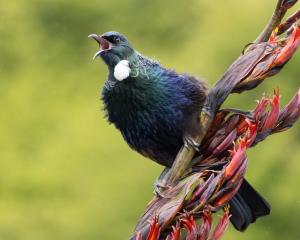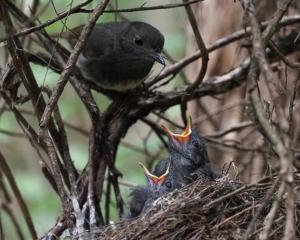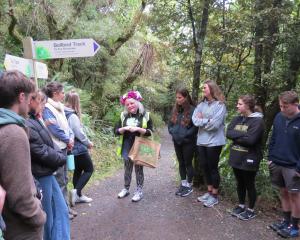Sirocco is coming back to Orokonui to get you hooked on kakapo conservation, writes Karin Ludwig.
If you did not see kakapo superstar Sirocco when he was at Orokonui Ecosanctuary two years ago, get ready to be amazed. Offering the public the only chance to see a living wild kakapo, he is coming back to Orokonui next month (September 6 to October 6).
At his first appearance at Orokonui in September 2011, Sirocco enchanted more than 1600 people and he correctly picked the All Blacks to win the Rugby World Cup.
What tricks will he get up to this time? Sirocco is one of just 124 kakapo left in the world and he is the only kakapo able to be viewed by the public.
As a small chick Sirocco suffered ill-health and had to be hand-raised, which resulted in his imprinting on humans.
He far prefers the company of people and does not seek out kakapo company.
That makes him the perfect kakapo to go on tour to raise awareness for the conservation of his species. And Sirocco really loves it.
He is naturally curious about people and loves interacting with them. The Department of Conservation, in partnership with New Zealand Aluminium Smelters Ltd and Forest and Bird, is charged with bringing this unique species back from the brink of extinction.
The story of the kakapo's decline is common to many native species.
Introduced predators and habitat loss can reduce a species to only a few animals toughing it out in marginal habitat - in the kakapo's case the remote nooks and crannies of Stewart Island and Fiordland.
Thirty years ago, kakapo numbers were at their lowest, with only 51 individuals rescued from predator-infested last refuges.
Early conservation efforts focused on moving individuals to the safety of predator-free offshore islands such as Codfish Island/Whenua Hou, off Stewart Island, where kakapo conservation efforts have been focused in recent years.
Kakapo now live on three predator-free offshore islands, closely monitored by Department of Conservation rangers.
Many traits of the kakapo's life-history are unusual, complicating efforts to save this species. For example, most parrots form a pair bond like other birds but not kakapo.
They are the only parrot with a lek breeding system.
Species with a lek breeding system aggregate in arenas, called leks, where males attract females with a display.
The most successful contestant will win most of the matings. But there is more to it.
Some years males successfully attract females to the mating arenas on the highest ridges with their 'booming' calls but other years there will be no breeding.
That's because, for kakapo females to even start thinking about raising two or three chicks on their own, an abundance of rimu fruit has to be available.
And that doesn't happen every year: it's not unusual for there to be no breeding two or three years in a row.
The kakapo's saving grace is that they are long-lived. But how long?
The oldest kakapo alive today were found as adults in the 1970s and '80s, and currently the best guess is that kakapo can live up to 90 years, although the average lifespan is currently believed to be about 60 years.
While the current population size has more than doubled in the past 30 years from the original population of 51, there are genetic challenges to ensure the long-term viability of kakapo.
Genetic diversity is crucial for small populations to recover and survive in the long-term.
It gives them the ability to survive environmental change and increases resistance to new diseases or parasites.
When kakapo were widespread throughout mainland New Zealand, the population had ample genetic diversity.
However only one bird from the mainland, named Richard Henry (after a pioneer conservationist), survived to join the Stewart Island birds in founding today's kakapo population.
The remnant Stewart Island population had very limited genetic variation, so much importance is placed on the genes of Richard Henry.
Luckily he mated with a Stewart Island bird and produced three offspring before he died.
Now it is up to these three birds to pass their genes on and keep some of the original mainland genes in the kakapo population.
Despite the challenges kakapo face, conservation efforts are achieving milestones every year to aid kakapo recovery. And Sirocco?
He remains a prime example of the heaviest, most endearing parrot in the world, the only flightless parrot species.
He is definitely a must-see for your bucket list!
Karin Ludwig, of the Department of Conservation, works with threatened species. She was Sirocco's 'minder' at Orokonui when he paid a visit two years ago.
The Wild Ways column appears in the Magazine section on the first Saturday of the month.












